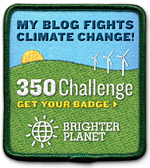Now I really like the NWF (National Wildlife Federation), they have a great website. They will certify your yard as a wildlife habitat with a few simple steps. If you don't want to get official, there are a lot of small things you can do to brighten up your favorite little person's day.
- Spread some bird seed around. Can you figure out each birds' unique tune?
- Stack twigs, leaves, and branches into a small pile and see who comes to visit.
- I have found that when I water my plants with the sprinkler, the dragonflies and birds flock to it.
- Grab a magnifying glass, how many insects can you find in a small patch of grass?
- Take a walk. Is there a nature preserve near you? How many animals can you find? Just taking a walk around my neighborhood, we can see rabbits, snakes, hawks, and even an alligator or two if I go down by the canal.
Now I know that this isn't exactly a 'green' post, but I truly feel that we need to get our kids interested in environmental issues. One of the ways to do this is to foster a love of the outdoors. Most kids like animals naturally, so when you help them to see them in their native habitats then they will strive hard to keep them there in the future.
Another thing we enjoy is camping, my daughter absolutely loves it, she has her own tent. Many weekend nights you can see the tent up in my backyard as she lays under the stars with our cat and a good book.
If you don't have a backyard, or it's still freezing in your neck of the woods then make your own camping spot. Throw a sheet up in the living room and place blankets, books, kids, and pets in a pile. (hint: if you use a small fan under the sheet, it will keep your tent nicely erected.)
Take them with you to the store and let them pick out seeds and plants to create their own gardening bed. They will love to watch the plants grow under their loving care. If you help them to plant a vegetable garden, you may be surprised at what types of veggies they may consume in the future.

my nephew Jack, being curious.
Kids are naturally curious, let's get them curious about our environment and we will create little foot soldiers on our quest to tread a little lighter.
















